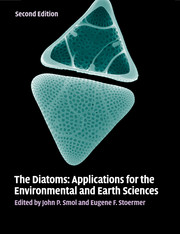Book contents
- Frontmatter
- Contents
- List of contributors
- Preface
- Part I Introduction
- Part II Diatoms as indicators of environmental change in flowing waters and lakes
- Part III Diatoms as indicators in Arctic, Antarctic, and alpine lacustrine environments
- 12 Diatoms as indicators of environmental change in subarctic and alpine regions
- 13 Freshwater diatoms as indicators of environmental change in the High Arctic
- 14 Diatoms as indicators of environmental change in Antarctic and subantarctic freshwaters
- Part IV Diatoms as indicators in marine and estuarine environments
- Part V Other applications
- Part VI Conclusions
- Glossary, acronyms, and abbreviations
- Index
- References
14 - Diatoms as indicators of environmental change in Antarctic and subantarctic freshwaters
from Part III - Diatoms as indicators in Arctic, Antarctic, and alpine lacustrine environments
Published online by Cambridge University Press: 05 June 2012
- Frontmatter
- Contents
- List of contributors
- Preface
- Part I Introduction
- Part II Diatoms as indicators of environmental change in flowing waters and lakes
- Part III Diatoms as indicators in Arctic, Antarctic, and alpine lacustrine environments
- 12 Diatoms as indicators of environmental change in subarctic and alpine regions
- 13 Freshwater diatoms as indicators of environmental change in the High Arctic
- 14 Diatoms as indicators of environmental change in Antarctic and subantarctic freshwaters
- Part IV Diatoms as indicators in marine and estuarine environments
- Part V Other applications
- Part VI Conclusions
- Glossary, acronyms, and abbreviations
- Index
- References
Summary
Introduction
The polar regions, both Arctic and Antarctic, show strong evidence of climate change affecting freshwater species, communities, and ecosystems, and are expected to undergo rapid and continued change in the future (IPCC, 2007). Diatoms in the freshwater and brackish habitats of inland waters of the Antarctic provide valuable records of their historic and modern environmental status. Antarctic habitats also contain a unique biodiversity of species many of which are found nowhere else on Earth. In this chapter, we review investigations using diatoms as indicators of environmental change in Antarctic and subantarctic island habitats, including lakes and ponds, streams and seepage areas, mosses and soils, cryoconite holes, brine lakes, and remarkable subsurface glacial lakes.
The Antarctic continent holds the vast majority of the Earth's freshwater, but the water is largely inaccessible because it is in the form of ice. Life is dependent upon liquid water, a substance scarce in Antarctica. Less than 0.4% of the continent is ice free, and it is within these ice-free regions that freshwater lakes and ephemeral streams form, fed by the melting of snow and glacial ice and occasional precipitation. These ice-free regions are located primarily near the Antarctic coastline (Figure 14.1). Of these regions, the “desert oases” of East Antarctica are considered to be the coldest, driest regions on Earth. In the limited parts of these oases where liquid water is available, even if present for only a few short weeks of the year, there is life (McKnight et al., 1999).
- Type
- Chapter
- Information
- The DiatomsApplications for the Environmental and Earth Sciences, pp. 267 - 284Publisher: Cambridge University PressPrint publication year: 2010
References
- 23
- Cited by



